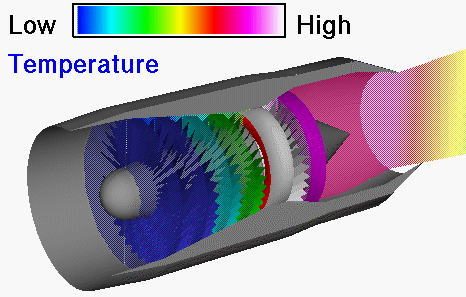 |
|
Glenn
|

 |
|
Glenn
|

Most modern passenger and military aircraft are powered by gas turbine engines, which are also called jet engines. The first and most simple type of gas turbine is the turbojet.
On this slide we show how the flow temperature varies through a typical turbojet engine. The temperature is color-coded, with blue indicating the lowest temperature and white the highest temperature. Air is brought into the turbojet through the inlet at the left of the computer drawing. At the rear of the inlet, the air enters the compressor. The compressor acts like many rows of airfoils, with each row producing a small increase in pressure. The increase in pressure is accompanied by an increase in temperature since the compressor is doing work on the flow. In the burner a small amount of fuel is combined with the air and ignited at near constant pressure. The temperature of the flow reaches a maximum in the burner. Leaving the burner, the hot exhaust is passed through the turbine. Energy is extracted from the flow by the turbine to turn the compressor, which is linked to the turbine by a central shaft. The temperature decreases across the turbine during this process, but the temperature entering the nozzle is still greater than free stream. The nozzle then converts the high pressure and temperature into high velocity. Because the exit velocity is greater than the free stream velocity, thrust is created as described by the thrust equation.
On a separate slide we discuss the computation of the engine temperature ratio (ETR), which is defined to be the total temperature ratio across the engine. Using our station numbering system, ETR is the ratio of nozzle total temperature (Tt8) to compressor face total temperature (Tt2). ETR can be easily measured on an operating engine and displayed to the pilot on a cockpit dial. If we know ETR and the corresponding engine pressure ratio (EPR), we can easily compute the thrust of an engine using the nozzle performance information and the thrust equation. The ETR is simply the product of the temperature ratio across all of the engine components. For a given engine design, we can determine the temperature ratio of each component as given on each of the component thermodynamic slides.
Go to...
byTom
Benson
Please send suggestions/corrections to: benson@grc.nasa.gov